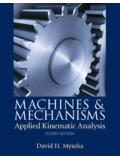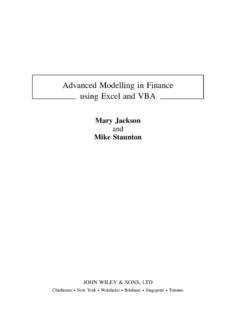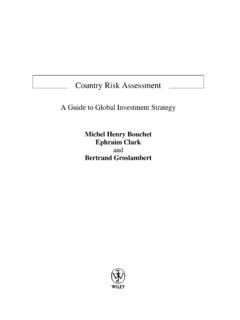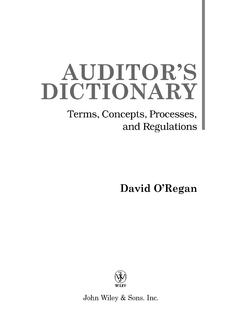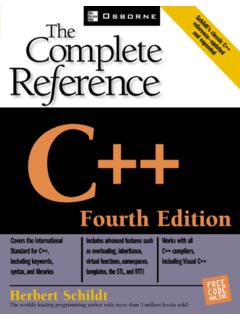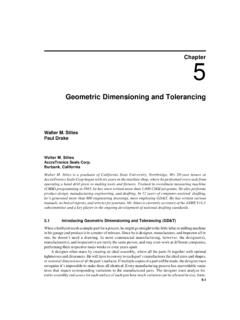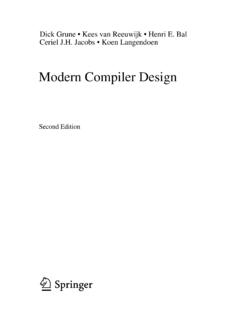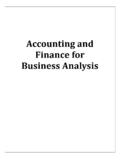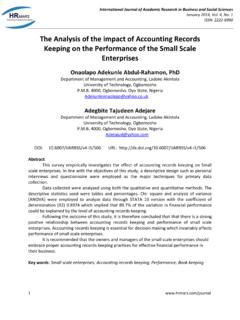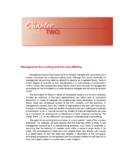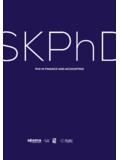Transcription of Accounting and Finance for Your Small Business - …
1 Accounting and Finance for your Small Business Second Edition STEVEN M. BRAGG AND. E. JAMES BURTON. John Wiley & Sons, Inc.. This book is printed on acid-free paper.. Copyright 2006 by PricewaterhouseCoopers. PricewaterhouseCoopers refers to the individual member firms of the worldwide PricewaterhouseCoopers organization. All rights reserved. Published by John Wiley & Sons, Inc., Hoboken, New Jersey. Published simultaneously in Canada. No part of this publication may be reproduced, stored in a retrieval system, or transmitted in any form or by any means, electronic, mechanical, photocopying, recording, scanning, or otherwise, except as permitted under Section 107 or 108 of the 1976 United States Copyright Act, without either the prior written permission of the Publisher, or authorization through payment of the appropriate per-copy fee to the Copyright Clearance Center, Inc.
2 , 222 Rosewood Drive, Danvers, MA 01923, 978-750-8400, fax 978-646-8600, or on the web at Requests to the Publisher for permission should be addressed to the Permissions Department, John Wiley & Sons, Inc., 111 River Street, Hoboken, NJ. 07030, 201-748-6011, fax 201-748-6008, or online at Limit of Liability/Disclaimer of Warranty: While the publisher and author have used their best efforts in preparing this book, they make no representations or warranties with respect to the accuracy or completeness of the contents of this book and specifically disclaim any implied warranties of merchantability or fitness for a particular purpose. No warranty may be created or extended by sales representatives or written sales materials. The advice and strategies contained herein may not be suitable for your situation. You should consult with a professional where appropriate.
3 Neither the publisher nor author shall be liable for any loss of profit or any other commercial damages, including but not limited to special, incidental, consequential, or other damages. For general information on our other products and services, or technical support, please contact our Customer Care Department within the United States at 800-762-2974, outside the United States at 317-572-3993 or fax 317-572-4002. Wiley also publishes its books in a variety of electronic formats. Some content that appears in print may not be available in electronic books. For more information about Wiley products, visit our Web site at Library of Congress Cataloging-in-Publication Data Bragg, Steven M.. Accounting and Finance for your Small Business / Steven M. Bragg. 2nd ed. p. cm. Rev. ed. of: Accounting and Finance for your Small Business / E.
4 James Burton, Steven M. Bragg. 2001. Includes index. ISBN-13: 978-0-471-77156-2(cloth). ISBN-10: 0-471-77156-2 (cloth). 1. Industrial management Handbooks, manuals, etc. 2. Business enterprises Finance . handbooks, manuals etc. 3. Small Business Management. 4. New Business enterprises . Management. I. Burton, E. James. Accounting and Finance for your Small Business . II. Title. 2006. 658 dc22. 2005056956. Printed in the United States of America 10 9 8 7 6 5 4 3 2 1. About the Authors S teven Bragg, CPA, CMA, CIA, CPIM, has been the chief finan- cial officer or controller of four companies, as well as a consult- ing manager at Ernst & Young and auditor at Deloitte & Touche. He received a Master's degree in Finance from Bentley College, an MBA from Babson College, and a Bachelor's degree in Economics from the University of Maine. He has been the two-time presi- dent of the Colorado Mountain Club, is an avid alpine skier and mountain biker, and is a certified master diver.
5 Mr. Bragg resides in Centennial, Colorado. He has published the following books through John Wiley & Sons: Accounting and Finance for your Small Business Accounting Best Practices Accounting Reference Desktop Billing and Collections Best Practices Business Ratios and Formulas Controller's Guide to Costing Controller's Guide to Planning and Controlling Operations Controller's Guide: Roles and Responsibilities for the New Controller Controllership Cost Accounting Design and Maintenance of Accounting Manuals Essentials of Payroll vii About the Authors Fast Close Financial Analysis GAAP Guide GAAP Implementation Guide Inventory Accounting Inventory Best Practices Just-in-Time Accounting Managing Explosive Corporate Growth Outsourcing Payroll Accounting Payroll Best Practices Sales and Operations for your Small Business The Controller's Function The New CFO Financial Leadership Manual The Ultimate Accountants' Reference Also: Advanced Accounting Systems (Institute of Internal Auditors).
6 Run the Rockies (CMC Press). Subscribe to Steve's free best practices newsletter at E. James Burton, , CPA, CFE, is dean of the College of Business and a full professor of Accounting at Middle Tennessee State University. He has founded, owned, managed, and sold a number of businesses in a variety of areas from service to manufac- turing. He received a Bachelor of Arts degree from MacMurray College in economics/ Business , a Master of Business Administration degree from Murray State University in management, and a in accountancy from the University of Illinois at Urbana-Champaign. In addition to over 50 journal articles, he has written Total Business Planning: A Step-by-Step Guide with Forms that has continued through three editions and translation into Norwegian. He resides in Murfreesboro, Tennessee. viii Contents Preface xiii Section I Preparing to Operate the Business 1.
7 Chapter 1 Budgeting for Operations 3. Definition or Purpose of an Operating Budget 3. Signs of Budget Ineffectiveness 4. Improvements to the Budgeting System 6. Responsibility Accounting 9. Budget Tracking and Maintenance 21. The System of Interlocking Budgets 25. Need for Budget Updating 35. Summary 36. Chapter 2 Investing in Long-Term Assets and Capital Budgeting 39. Definitions 40. Overview and Use of Capital Budgeting 41. Life Cycles 42. Capital Budgeting Sequence 43. Producing Numbers to Get Dollars, the Use of Forms, and the Capital Budgeting Model 48. Miscellaneous Considerations 65. Product Discontinuance 66. Bailout 68. ix Contents Summary 69. Appendix: Examples and Comparison of Calculations 70. Chapter 3 Basic Control Systems 77. The Need for Control Systems 77. Types of Fraud 79. Key Controls 81. When to Eliminate Controls 97.
8 Summary 99. Section II Operating the Business 101. Chapter 4 Cash Flow Concerns 103. Cash 103. What to Do with Excess Cash 105. Cash Flows 108. Introduction to Cash Flow Budgets 112. Indications of Cash Flow Problems 112. Managing Cash 113. Preparation of the Cash Budget 126. Disbursements 127. Net Cash Flow and Cash Balances 130. Exceptions to Expected Cash Flows 131. Summary 132. Appendix: Cash Flow Example 133. Chapter 5 Financing 143. New Businesses 143. Zero Working Capital and Zero Fixed Assets 144. Types of Financing 148. Private Placement of Stock 157. Swapping Stock for Expenses 158. Stock Warrants 159. Stock Subscriptions 159. How to Obtain a Bank Loan 160. Sources of Debt Financing 167. Types of Loan Arrangements 168. Restrictions on Loans 171. Conditions That a Borrower Should Seek 173. Summary 175. x Contents Section III Evaluating the Operations of the Business 177.
9 Chapter 6 Performance Measurement Systems 179. Financial Ratios 180. Types of Financial Ratios 182. Using Performance Measurements for Predictions 193. Operating Ratios 196. Other Ratios 202. The Balanced Scorecard 204. Summary 207. Chapter 7 Financial Analysis 209. Risk Analysis 209. Capacity Utilization 215. Breakeven Analysis 222. Summary 229. Chapter 8 Taxes and Risk Management 231. Controlling Tax Liabilities 232. Risk Management 237. Insurance 245. Types of Insurance Companies 249. Claims Administration 250. Summary 252. Chapter 9 Reporting 255. Federal Government Requirements 255. State Government Requirements 262. Local Government Requirements 267. Creditors 268. Equity Holders 269. Management Reports 269. Summary 286. Index 289. xi Preface T his book has been written for Business owners and managers who want to refine the Accounting and financial operations of their companies.
10 It provides detailed information about how to run these operations, track cash flows, conduct analyses, analyze key financial information, create a corporate risk management strategy, and manage tax liabilities in short, all of the key Accounting and financial information required to operate a Small Business . Chapter 1 reveals the interlocking system of budgets, as well as how to set up a budgeting procedure and use standard budgeting formats to ensure that revenues are properly projected and matched to related costs. This is a very important issue for those cyclical industries in which expenses may be incurred well in advance of sales receipts; it is also a highly necessary method for controlling such key expense areas as payroll and inventory. Chapter 2 covers the budgeting techniques used for capital acquisition, such as discounted cash flows and payback analysis.
